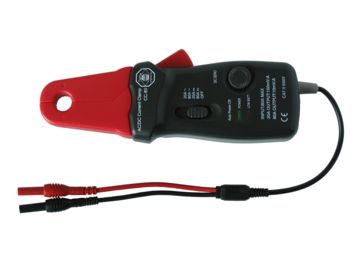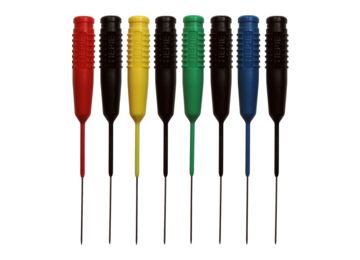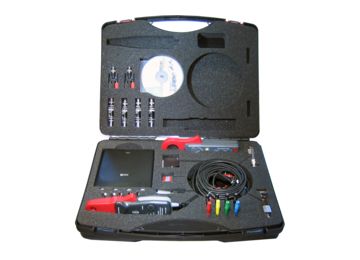Actuator information
| Type: | Direct injection, servo hydraulic injector |
|---|---|
| Power supply: | - |
| Signal type: | Frequency varying |
| Signal level: | 12 V to 80 V |
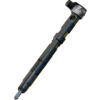
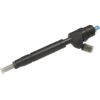
Workings of a servo hydraulic injector
Today's advanced diesel engines are getting more powerful and quieter. A part of this achievement can be contributed to the way the fuel is precisely injected. Mechanical direct injection has been used in diesel engines for a long time. It can be precise, but to achieve lower emissions, it has been replaced by electronically controlled direct injection. An electronic injector can be precisely controlled by an ECU.
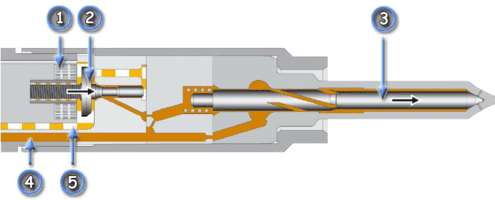
The direct injector measured for this article is of the servo hydraulic type, pictured in figure 1. The following parts can be distinguished:
- solenoid
- control valve
- injector needle
- high pressure inlet fuel
- low pressure return fuel
Like in a classic mechanical injector, both the control valve and injector needle are being closed by a spring. The control valve is moved by the coil which is powered by the ECU when an injection is needed. The coil and control valve electrically work similar to the indirect injector. The control valve operates a hydraulic circuit which is the high pressure fuel, to control the movement of the injector needle.
When an injection is needed, the ECU opens the control valve by applying a voltage to the coil. When the control valve lifts, pressure is released from the base of the injector needle. The difference between the low pressure at the base of the injector needle and high pressure at the tip causes the needle to move from its seat and allow fuel to pass through.
To stop the injection, the control valve is closed, causing the fuel pressure at the base of the injector needle to increase, making its spring push the needle back to its closed position.
Connecting the lab scope
Correct functioning of the servo hydraulic injector can be checked by measuring the following signal voltages, see figure 2:
| Channel | Probe | Voltage | Range |
|---|---|---|---|
| 1 |  |
Injector voltage positive side | 80 V |
 |
Injector voltage negative side | ||
| 2 |  |
Current clamp positive connection | 4 V |
 |
Current clamp negative connection |
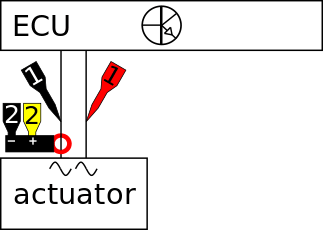
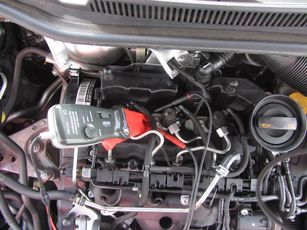
Channel 1 of the lab scope is connected to the servo hydraulic injector via a Measure lead TP-C1812B and Back Probe TP-BP85. The current is measured with a Current clamp TP-CC80 which is connected to channel 2 of the lab scope with the use of a Measure lead TP-C1812B. The Current clamp TP-CC80 is set to the 20 ADC range and outputs a voltage of 100 mV per 1 A. To get a readout in Ampères, the current clamp's signal voltage has to be amplified 10 times. This can be done via the menu item "probe settings" in the right click menu of channel 2. In that same menu the "Set unit..." can be used to change the unit to 'A'. The lab scope is set to normal scope mode.
Measuring
Figure 3 shows the voltage at and current through a servo hydraulic injector when idling at operating temperature. This measurement can be downloaded and used to correctly set up the lab scope or as reference signal.
Download direct servo hydraulic injection measurement
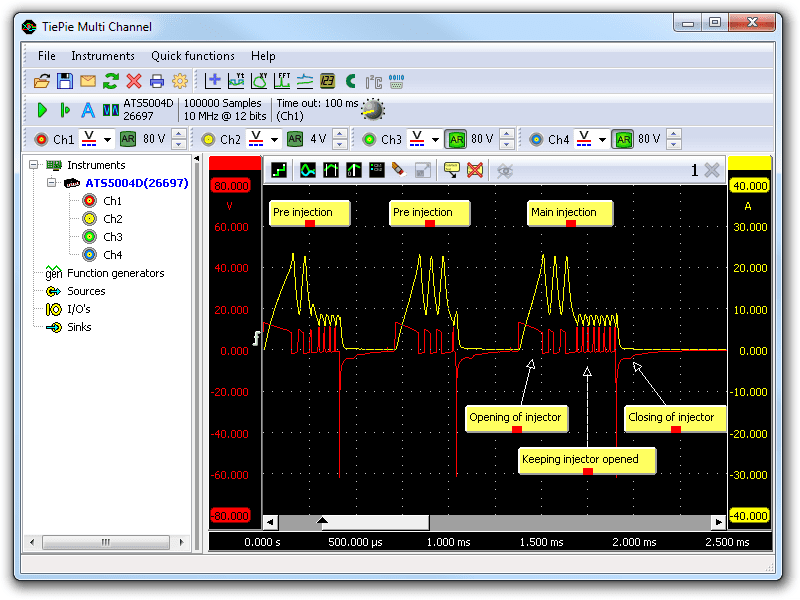
Channel 1 (red) in figure 4 shows the injector voltage and channel 2 (yellow) the current through the servo hydraulic injector. The signals consist of three injections, of which the first two are pre injections and the last is the main injection.
Let's concentrate on the main injection visible in figure 4. The red line shows the control valve is opened with a relative long high voltage followed by two smaller pulses. The high current of around 15 A lasting for 300 µs shows the amount of energy needed to open the control valve. Once opened, the ECU keeps the control valve open by applying a low duty cycle voltage. This results in a lower current of around 8 A using less energy to keep the valve open. When the injection needs to be stopped, the ECU stops applying the voltage. A spike in the injector voltage is visible and after that a small notch which indicates the control valve is closing.
During the injection the current is high but lasts only for about 550 µs. This means that the overall applied energy is low, around 16 mJ for the main injection.
Diagnosis
Signal values may differ for different types of engine control units and servo hydraulic injectors. Consult ATIS for information on specific engine control units and injectors.
The following servo hydraulic injector voltage (channel 1) deviations can indicate a problem:
-
No signal:
Cause: back probes have no connection (perform a connection test) -
Signal voltage too low:
Cause: resistance in wiring to ECU -
Noisy signal:
Cause: signal wires damaged, poor connection in connector terminals, injector defective -
Signal shows an offset in relation to the example signal:
Cause: resistance in wiring to ECU, scope is not set to DC coupling:
The following servo hydraulic injector current (channel 2) deviations can indicate a problem:
-
No signal:
Cause: current clamp not properly connected (perform a connection test), current clamp isn't switched on or has a empty battery, injector defective -
Signal voltage too high:
Cause: current clamp was not properly zeroed -
Noisy signal:
Cause: signal wires damaged, poor connection in connector terminals, injector defective -
Signal shows an offset in relation to the example signal:
Cause: current clamp was not properly zeroed
RELATED PRODUCTS
RELATED ARTICLES
- Indirect injection current measurement
- With a lab scope an injector current is measured on an idling engine at operating temperature. The measured current is shown and can be downloaded. To help determining whether the injector is functioning correctly, different possible deviations from the example signal are mentioned along with possible causes.
- Indirect injection voltage measurement
- A lab scope is used to measure an injector signal voltage on an idling engine at operating temperature. The signal from the sensor is shown and can be downloaded. To help determining whether the injector is functioning correctly, different possible deviations from the example signal are mentioned along with possible causes.
- Fuel Pressure Sensor And Metering Valve
- With a lab scope a fuel pressure sensor and fuel metering valve signal voltage are measured on an engine under various conditions. The signal from the fuel pressure sensor and metering valve are shown and can be downloaded. To help determining whether the fuel pressure sensor and metering valve are functioning correctly, different deviations from the example signal are mentioned along with possible causes.
This document is subject to changes without notification. All rights reserved.
The information in this application note is carefully checked and is considered to be reliable, however TiePie engineering assumes no responsibility for any inaccuracies.
Safety warning:
- Before measuring, check that sources of dangerously high voltages are switched off or shielded from contact. Voltages considered to be dangerous are voltages over 30 V AC RMS, 42 V AC peak or 60 V DC.
- Keep a clean working environment when doing measurements.
- This measurement and procedures are a examples / measuring suggestions and are no prescribed protocols.
- TiePie engineering can not anticipate the safety actions that need to be taken to protect persons and appliances. Before starting a measurement, check which safety measures need to be applied.

